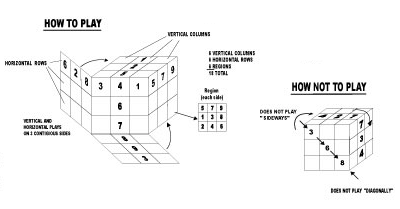 |
 |
 |
The History of Sudoku
Although the name Sudoku is a Japanese acronym, the puzzle was invented in the United States. It was anonymously designed by Howard Garns, a retired architect who after specializing in the construction of buildings, concentrated on the construction of puzzles. Dell Magazines first published the puzzle under the name Number Place in 1979.
However, it was in Japan that the puzzle gained popularity. In April 1984, The Monthly Nikolist introduced the puzzle to Japan under the name Suuji wa dokushin ni kagiru which means, "The numbers must be single". In other words, each number must appear once and only once in a row, column or region. The puzzle was named by Maki Kaji, the president of Nikoli, with the catchy acronym of Sudoku. As its popularity rapidly increased in Japan, it evolved into its present form under different titles in mainstream Japanese periodicals.
In 1989, Loadstar/Softdisk Publishing published DigitHunt on the Commodore 64, apparently the first home computer version of Sudoku. Later, in 1996, Yoshimitsu Kanai published his version of the computerized puzzle under the name Single Number for the Apple Macintosh in Japanese and English, for the Palm PDA and for the Mac OS-X in 2005.
After seeing the Sudoku puzzle in a Japanese publication, Wayne Gould, a retired Hong Kong judge, originally of New Zealand, worked six years to convert the paper version into a computerized version that would write the puzzles instantaneously. Because the British press has a long, successful history of publishing crossword puzzles, Mr. Gould promoted Sudoku to the Times in London. On February 23, 2005, The Daily Telegraph introduced the puzzle on a daily basis and the newspaper's sales increased dramatically due to the readership playing Sudoku. The British media took notice and on July 1, 2005, the first live TV Sudoku game program, "Sky One," aired. Sudoku then spread throughout the European Common Market.
The sudoko craze hit the United States during the second half of 2005, with newspapers and TV picking up the puzzle. CBS Broadcasting aired several TV shows on Sudoku. It has come full circle, back home to its birthplace in the USA. Today, virtually every major daily in the United States has a Sudoku puzzle and Sudoku books remain top-sellers. Sadly, Howard Garns, the inventor of the original puzzle, did not live to see its universal popularity.
Sudoku is now a global phenomenon, thanks to the combination of its irresistible mind-challenging principles, its use of the universal language of Aramaic numbers, and instantaneous global communication. With its billions of possible puzzle combinations -- each with its unique solution that can be reached from various starts -- Sudoku provides an inexhaustible, addictive, and satisfying fun.
Sudoku is here to stay, proof that the world population still loves a good puzzle!

The SuDoKu Cube
was invented by Jay
Horowitz on March 16, 2006
The SuDoKu Slide was invented
by Jay Horowitz on June
28, 2006
The SuDoKu Solitaire was invented
by Jay Horowitz on January
16, 2007

  
The History of Kakuro
The first type of these puzzles, originally named Cross Sums, were published in 1996 by Dell Magazines, the same American Publication which introduced Sudoku Puzzles under the name of Number Place to the world (Galanti).
Six years after their initial release in Japan, Nikoli re-branded "Kasan Kurosu" as Kakuro (Galanti).

|
|
 |
|





